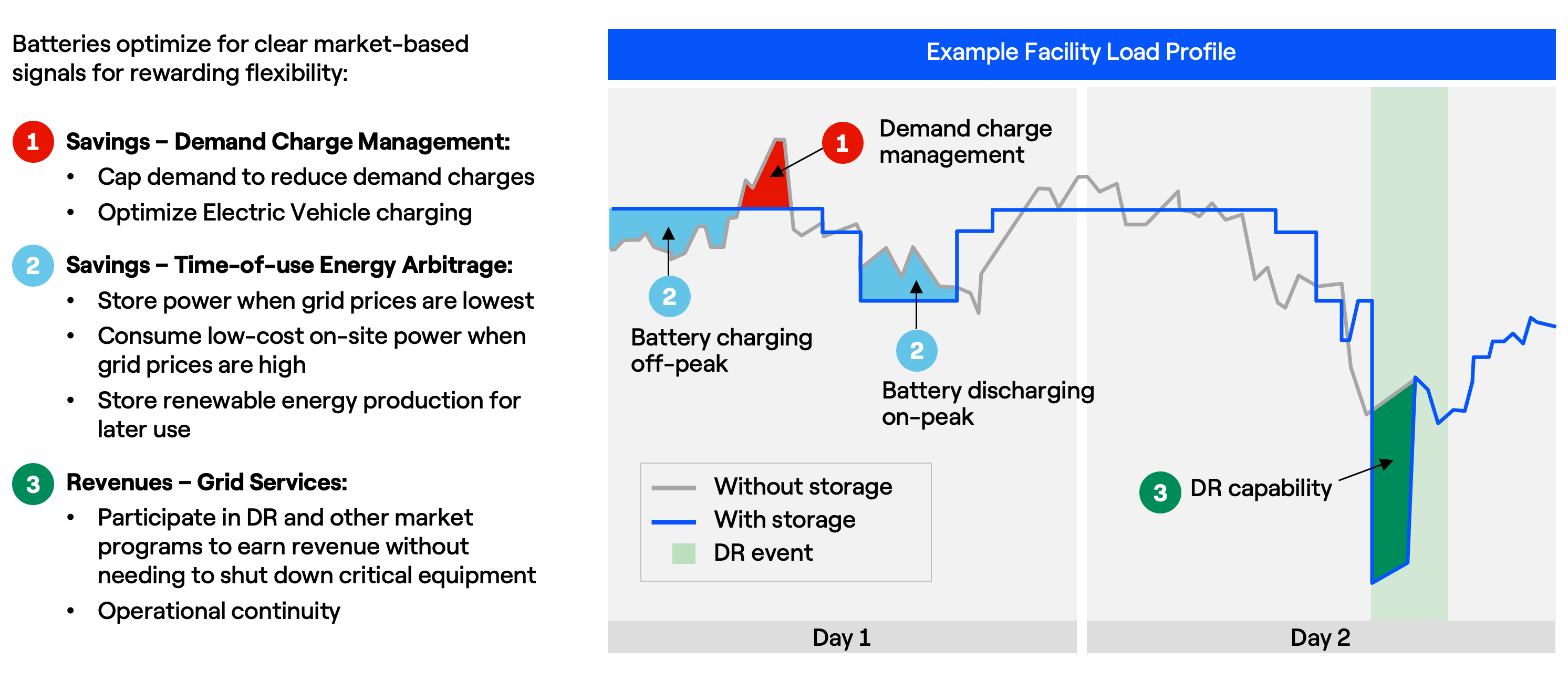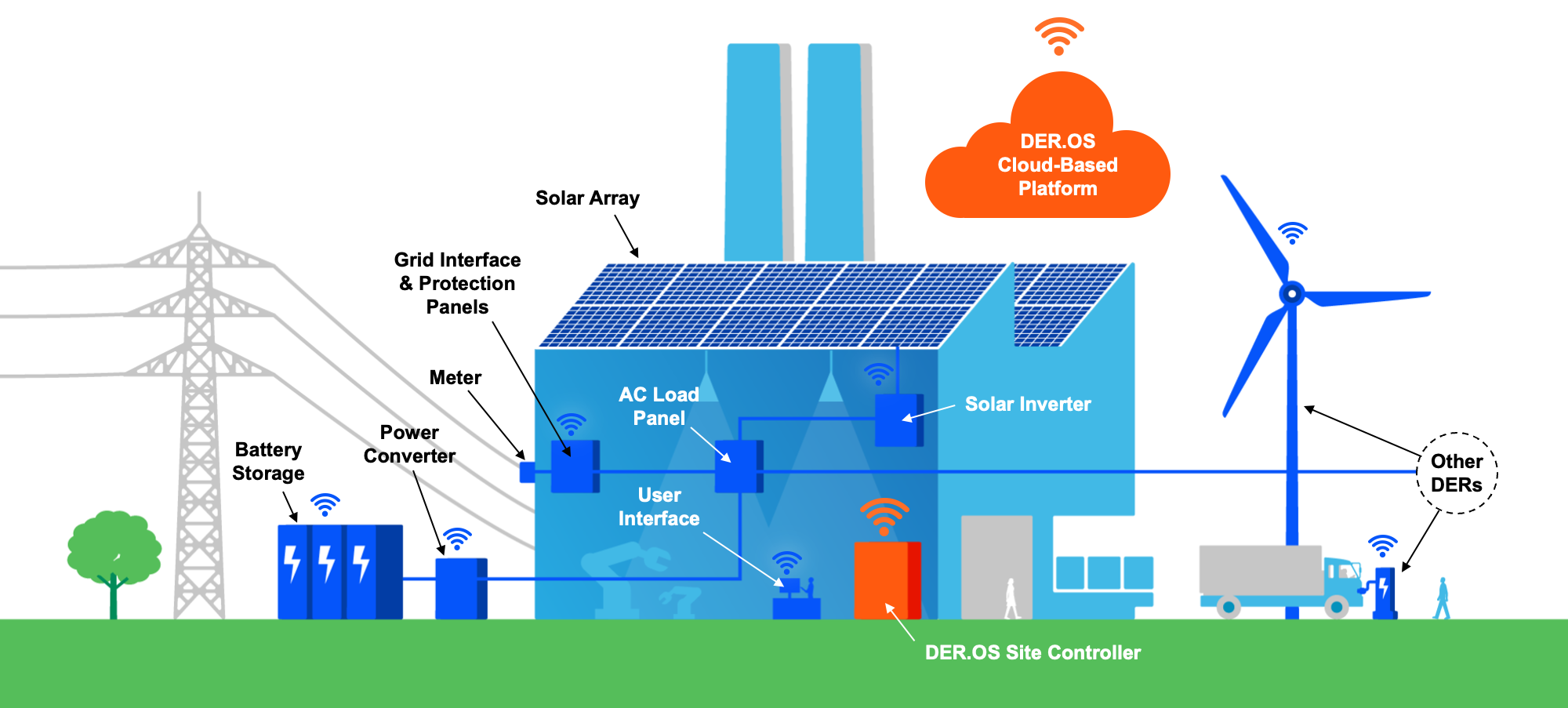07 07, 2023
{{ content.title }}
{{ content.description }}
Distributed energy resources (DERs) like solar and storage play a key role in helping organizations decarbonize their on-site operations, but they do this best when paired with optimization software. Smart control of these resources enable end-users to better manage their energy usage, supporting multiple demand-side management strategies.
Bundling these multiple strategies together is a process called “value stacking.” By value stacking, you tap into multiple value streams simultaneously to improve the economics for your DER technology investments by improving the return on investment and reducing the payback period.
So what should you know about value stacking to maximize the value of your DER investments?
Defining battery storage value stacking
A well-designed and optimized behind-the-meter (BTM) battery energy storage system unlocks the opportunity for value stacking or “stacking services" – leveraging the same equipment, system, or process to deliver multiple benefits that maximize the total financial impact. The image below demonstrates how a battery energy storage system alters one site’s energy usage to provide 3 different value streams: demand charge management, time-of-use energy arbitrage, and grid services like demand response.
3 value streams for battery storage

- Demand charge management: With battery storage, organizations can reduce costly demand charges that account for a significant amount of annual energy costs by reducing demand at the right time.
- Time-of-use charge management: Battery storage can enable organizations to avoid daily peak prices by reducing grid demand in line with energy providers’ time-of-use periods.
- Demand response: Organizations can leverage battery storage to create revenue by participating in demand response programs, while minimizing energy curtailment required at the site level.
Value stacking these kinds of services is typically easiest with the deployment of a battery energy storage system. While these are just a few examples of services that organizations can leverage, value streams like these can enable some organizations to create hundreds of thousands of dollars in value every year – if they are managed properly.
The challenges to achieving battery storage value stacking
The obstacle to stacking multiple value streams has traditionally been the difficulty in finding compatibility between those streams and balancing them properly. Without an intelligently optimized approach, stacking multiple streams is difficult and could result in missed financial opportunities and negative impacts on battery performance or operating life.
For example, on a given day, a battery energy storage system may be able to perform renewable energy firming while also helping to manage time-of-use charges and participate in demand response programs. But the amount and timing of each maneuver would depend on a number of different factors, among them cloud cover, the building’s operational schedules, organizational load requirements, and more.
If this sounds complicated, that’s because it is. As an analogy, think about how the best altitude is determined for a passenger jet during a long flight, which requires balancing considerations like passenger ride quality, fuel consumption, safety, and time of arrival. At the same time, the calculation must also account for how the winds change throughout the flight path and react while maintaining the balance of the other considerations. In the same way, buildings need to leverage all available demand-side value streams while accounting for other variable factors, such as changing electrical loads and battery degradation, to optimize the value of their battery storage assets.
The key to battery storage value stacking: real-time optimal control
A battery energy storage system platform with real-time optimal control is capable of continually balancing participation in multiple value streams simultaneously – and it’s most essential when they may compete with one another. Not only that, when considering any battery activity, the impact on battery degradation must be continuously taken into account.
A real-time optimization control system analyzes all aspects of the building’s energy situation – tariffs, incentives, demand response programs, battery chemistry and sizing, etc. – while also learning the building’s energy consumption patterns. Armed with this data, the system plans and automatically executes a control strategy that deploys the battery energy storage system to deliver the maximum total economic value from all available value streams and extend battery life. As a result, organizations maximize their ROI from these assets, while also capitalizing on sustainability and energy resilience benefits.
Enel’s DER.OS optimization software is uniquely positioned to help organizations optimize the value of their DERs by enabling value stacking. The software uses real-time optimal control to balance participation in multiple value streams while also considering the impact on battery degradation.
Optimization software is key to effectively coordinating DERs like battery storage

Why Enel?
Simply deploying optimization software is not sufficient to maximize the value of your battery storage assets. You need to be sure that your energy partner behind that software has knowledge and expertise in tuning the optimization process, accessing wholesale energy markets, and maintaining real-time dynamic tariff libraries to unlock this full stack of value.
At Enel, we have more than 20 years of experience managing complex market dynamics around North America and working with a diverse set of stakeholders, like grid operators, utilities, and government agencies. By leveraging our decades of experience interacting with wholesale markets, we have built industry expertise that enables us to predict market conditions and adjust our dispatches accordingly. This means that you can rely on our software to help your organization make informed decisions and optimize the value of your DER assets.
Contact our team today for a tailored distributed energy resources strategy and to find out how much bill savings and grid revenues you can unlock by leveraging smart DERs to stack multiple value streams.